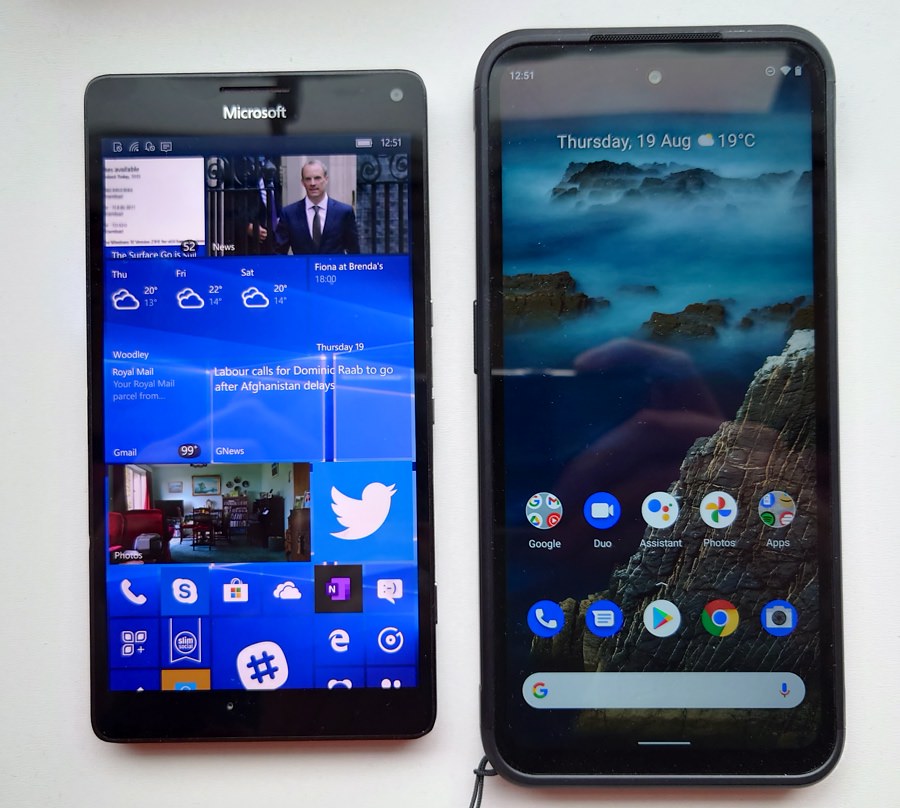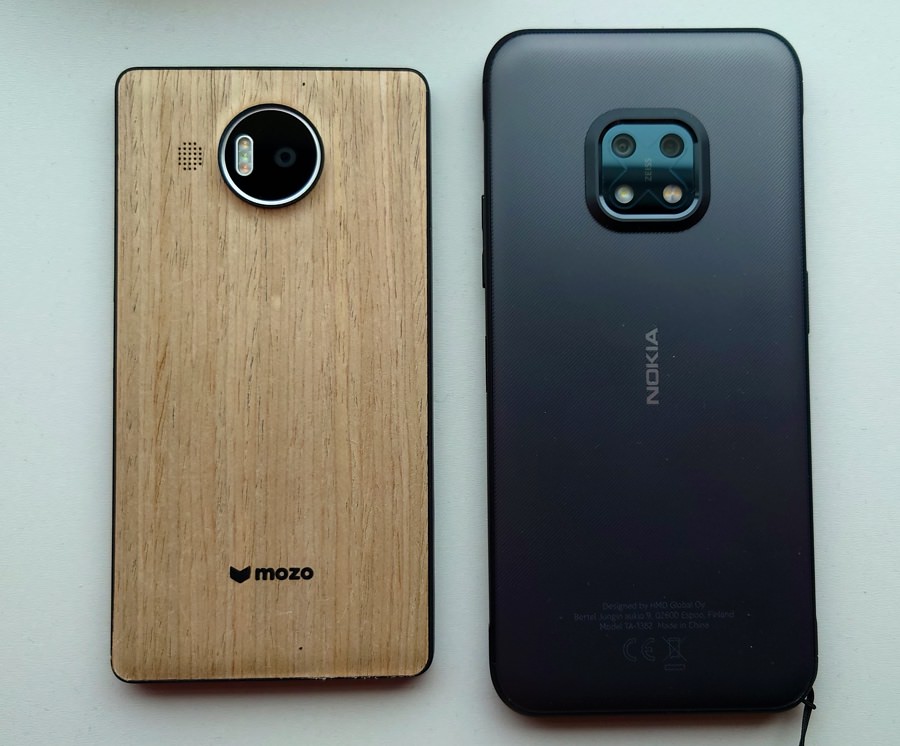Lumia 950 XL and Nokia XR20
As usual, just for fun and curiosity, I've shaded in green an obvious 'win' for either device. Any row where a winner would be totally subjective is left uncoloured. Or, where all devices are utterly excellent but in different ways, I've given each a 'green'(!)
[By the way, if you're viewing this feature on a phone then the table may well cause you problems. Try viewing in landscape mode? Failing that, go view this on a laptop or tablet!]
| Microsoft Lumia 950 XL | Nokia XR20 | |
| Date first available | November 2015 | August 2021 |
| Current price, availability | No longer officially for sale, though it's often on clearance prices if you're lucky and at outrageous profiteering prices due to rarity (if you're not!) | £399 on Amazon UK inc VAT |
| Dimensions, form factor, weight | 152 x 78 x 8mm, plastic chassis and replaceable backs (plastic/leather/wood etc, from Mozo, as modelled here, though you'll have to look on the clearance market and eBay at this stage), 165g, bezels are comparatively small. It's not often the 950 XL looks small compared to another phone, but...! | 172 x 81 x 11 mm, 248g, quite a bit taller, thicker, and significantly heavier |
| Durability | No specific durability metrics, though the fact that the back comes off will help enormously for water damage, i.e. taking out battery and cards immediately, drying out the internals, even unscrewing the motherboard from the guts of the phone. I'm old-school here! All damage to the back or corners is trivial through replacement of the rear, but the screen's exposed, of course. The plastics used should absorb shock and, anecdotally, I've never bothered putting a case on any Lumia. Just saying. I think that fact is significant. |
Polymer composite, Aluminium side panels, Aluminium core Corning Gorilla Glass Victus for the main display MIL-STD-810H durable, IP68, Up to 1.8m drop protection, Up to 1.5m water protection for 1 hour, Accessory attachment loop |
| Operating system, interface | Windows 10 Mobile, (dismissable) virtual controls, as needed, now officially updated to W10 Fall Creators Update (Redstone 3, Autumn 2017) with security to 'January 2020'. |
Android 11, August 2021 security, gesture controls by default or navigation buttons on-screen as an option An extra custom (red) button on the top gives access to two commonly used functions, such as torch or camera. And there's a Google Assistant button on the phone's left, for direct access. Plus SOS Torch facility (long press the torch icon), super bright, good for being rescued on mountain tops(!) Giving the win here now because using Android or iOS is now more or less compulsory, W10M and other niche OS just haven't got the services and support. |
| Display | 5.7" AMOLED (1440p at 16:9 aspect ratio, matching most video media), Gorilla Glass 4, ClearBlack Display polarisers help with outdoor contrast, excellent viewing angles. Screen area is approximately 88 cm2
Glance screen available (in various colours) for always-on time, day and notification icons, plus some detailed info from a specified app. |
6.67" 1080p IPS LCD display, 20:9 ratio, Gorilla Glass Victus, screen area is roughly 107cm2
Excellent clarity and colours, LCDs have got so good now that they're up with AMOLED other than in complete darkness and brightest sunshine. There's an 'Always on' 'Glance' display with highly customisable time, date and battery status, though turned off by default to save power. |
| Connectivity | LTE, NFC (all uses), Wi-Fi b/g/n/ac, integral wifi tethering, Bluetooth 4.2 (all uses).
Continuum connectivity, wired or wireless, to use a wide range of first and third party UWP apps on external displays as secondary screen, independent of the phone display. Includes the NexDock 2, transforming the Lumia into a Windows 10 S laptop, effectively. Though a workaround is needed for the newer NexDock Touch! |
LTE, 5G, NFC (all uses), Wi-Fi b/g/n/ac/6, integral wifi tethering, Bluetooth 5.1 (all uses). |
| Processor, performance | Snapdragon 810 chipset, 3GB RAM, faster than it's ever been now on the Fall Creators Update though still slower for almost everything than on the Android phone. Multi tasking and app resumption is excellent though, at least with all the modern UWP apps |
Snapdragon 480, 4/6GB RAM (depending on variant), lightning fast at everything |
| Capacity | 32GB internal storage, expandable via (cheap) microSD to extra 256GB | 64/128 GB internal storage (depending on variant), microSD expansion |
| Imaging (stills) | 20MP PureView f/1.9 1/2.4" sensor. Phase Detection auto-focus, dedicated camera shutter button and launch key, 1.5x lossless digital zoom (in 8MP oversampled mode, and lossy digital after that), OIS. 'Rich Capture' produces customisable HDR shots and 'dynamic flash', with triple LED illumination. Outstanding shots in most light conditions, with just focussing issues in low light as an Achilles heel. |
48 MP, f/1.8, 1/2.25", PDAF An imaging shootout is coming up in a few days. Please check back - I don't expect this ruggedised Nokia to defeat the older Lumia, but it's always interesting to see how newer technology can overcome older specialisms. |
| Imaging (front/selfie) |
5MP front camera | 8 MP, f/2.0, 1/4.0" fixed focus front camera |
| Imaging (video) | Up to 4K, optically (and optionally digitally) stabilised, with 'Best photo' 8MP grabbing built-in, plus Rich Recording and HAAC microphones for high quality, gig-level stereo capture. | Up to 1080p/60fps stabilised video capture and high quality stereo audio capture. |
| Music and Multimedia (speakers) |
A tinny mono speaker by modern standards, though as ever you can trade volume for fidelity in a simple tweak on Lumias. | Decent stereo speakers, loud but no fidelity, quite 'middly' - still miles better than the Lumia 950 XL here, though! |
| Music (headphones) |
3.5mm headphone jack, A2DP+AptX, plus a decent internal DAC, so great wired and wireless headphone audio too. | 3.5mm headphone jack, decent quality and volume but currently plagued by sound break up in the left channel at low and mid-level volumes, it's not clear whether this is a software or hardware issue. Updates will prove it one way or the other! Plus A2DP, AptX Adaptive via Bluetooth or plug in a Type C DAC for best results. |
| Navigation | Windows 10 Maps is now pretty mature and impressive, especially once you've learned the live traffic routine trick! Offline maps save a lot of data bandwidth for those on tight contracts or anyone in a low signal (data) area. But it's all looking a little neglected in 2020 compared to the bells and whistles in Google Maps. And even live traffic is now becoming erratic. |
Google Maps is now the gold standard in phone navigation, tied in with many other Google services and offering true real time navigation around traffic issues, even at local level, along with offline maps that auto-update. |
| Cortana/Voice | Cortana was in theory now mature and well integrated, though functionality has been falling away and most attempts to rouse her end in failure in 2021. | Google Assistant is available via voice, swipe or button, and works well, far superior to the dying Cortana in 2020, due to the investment that Google has put in over the last few years. |
| Battery, life | Removable 3000mAh battery, and the ability to change cells are a positive here (and you CAN still buy decent spare batteries), plus USB Type C Power Delivery (up to 3A, so 15W) and 1A Qi wireless charging built-in also helps. However, a Lumia running Windows 10 Mobile will now discharge in 24 hours(!!) even if you don't use it much, so it's a win here with caveats! |
Sealed 4630mAh battery, gets easily through a day, with charge to spare. Type C port supports fast (enough) 18W wired charging, plus 15W Qi charging. |
| Cloud aids | Windows Photos syncs at full resolution and quality across all signed-in devices, subject to your OneDrive tariff (stingy, unless you have Office 365 - most of us do, hence the 'win' here), should you have thousands of images in the system. Plus Windows 10 backs all your media, application data and settings to a separate backup folder system, tariff-free on OneDrive, for easy restoration on a new or factory reset phone. See my feature on media cloud storage. | Google Photos does a great job of editing and organising photos, syncing them across all signed-in phones and tablets, albeit at 'reduced' quality (re-compression server-side). |
| File compatibility | As with all Windows phones, plugging into a Windows PC gives full drag and drop to the phone's user file system. Plugging into a Mac is more problematic, though seems to work under Catalina. | Plugging into any PC gives immediate MTP file access, plus this works on a Mac on all OS versions, with Google's Android File Transfer utility, for drag and drop of all user files. Seamless and lightning fast. |
| Biometrics | Iris recognition ('Windows Hello') works well unless you wear varifocals(!), but takes a couple of seconds (including an animation!) in real world use. There's also no official way of paying in shops using this. | The capacitive fingerprint scanner in the power button works well to unlock the phone and to authenticate transactions, as you'd expect, with Google Pay or in the Play Store. |
| Applications and ecosystem | Windows 10 Mobile had most (though not all) mainstream apps and services covered, though some are dropping away now - see my guide! Often third party clients are involved, mind you, there are companies who hate Microsoft so much that they simply refuse to write for Windows, it seems. And 'long tail' niche/boutique apps are hard to find for real world companies and shops. | The might of Google and Android's app ecosystem - everything is available and almost always in first party form.
|
| Upgrades and future | Windows 10 Mobile is now effectively out of support. From now on, it will be useable but with more and more service caveats applying. Still, 'January 2020' was well over four years since the Lumia 950 XL was launched, so it's hard to complain in terms of longevity. | Three years of OS updates (so mid 2024) and a further year of security updates, all promised. |
Verdict
Adding up the green 'wins' (for fun?!) gives a whopping 14-6 win to the much newer device, which is expected. Given the importance of imaging these days, I guess a lot will depend on whether this new Nokia has a serviceable camera. Don't worry, I'm shooting test photos on each and an imaging feature is next, don't worry!


